
A musical ensemble, also known as a music group or musical group, is a group of people who perform instrumental and/or vocal music, with the ensemble typically known by a distinct name. Some music ensembles consist solely of instrumentalists, such as the jazz quartet or the orchestra. Other music ensembles consist solely of singers, such as choirs and doo wop groups. In both popular music and classical music, there are ensembles in which both instrumentalists and singers perform, such as the rock band or the Baroque chamber group for basso continuo and one or more singers. In classical music, trios or quartets either blend the sounds of musical instrument families or group together instruments from the same instrument family, such as string ensembles or wind ensembles. Some ensembles blend the sounds of a variety of instrument families, such as the orchestra, which uses a string section, brass instruments, woodwinds and percussion instruments, or the concert band, which uses brass, woodwinds and percussion.
Rock is a broad genre of popular music that originated as "rock and roll" in the United States in the late 1940s and early 1950s, developing into a range of different styles from the mid-1960s, particularly in the United States and the United Kingdom. It has its roots in 1940s and 1950s rock and roll, a style that drew directly from the blues and rhythm and blues genres of African-American music and from country music. Rock also drew strongly from genres such as electric blues and folk, and incorporated influences from jazz, classical, and other musical styles. For instrumentation, rock has centered on the electric guitar, usually as part of a rock group with electric bass guitar, drums, and one or more singers. Usually, rock is song-based music with a 4
4 time signature using a verse–chorus form, but the genre has become extremely diverse. Like pop music, lyrics often stress romantic love but also address a wide variety of other themes that are frequently social or political. Rock was the most popular genre of music in the U.S. and much of the Western world from the 1950s to the 2010s.
Glam rock is a style of rock music that developed in the United Kingdom in the early 1970s and was performed by male musicians who wore flamboyant and feminine clothing, makeup, and hairstyles, particularly platform shoes and glitter, and female musicians who wore masculine clothing. Glam artists drew on diverse sources across music and throwaway pop culture, ranging from bubblegum pop and 1950s rock and roll to cabaret, science fiction, and complex art rock. The flamboyant clothing and visual styles of performers were often camp or androgynous, and have been described as playing with other gender roles. Glitter rock was a more extreme version of glam rock.

Susan Kay Quatro is an American singer, bass guitarist, songwriter and actor. In the 1970s, she scored a string of singles that found success in Europe and Australia, with both "Can the Can" (1973) and "Devil Gate Drive" (1974) reaching #1 in several countries.
Pop rock is a fusion genre characterized by a strong commercial appeal, with more emphasis on professional songwriting and recording craft, and less emphasis on attitude than standard rock music. Originating in the late 1950s as an alternative to normal rock and roll, early pop rock was influenced by the beat, arrangements, and original style of rock and roll. It may be viewed as a distinct genre field rather than music that overlaps with pop and rock. The detractors of pop rock often deride it as a slick, commercial product and less authentic than rock music.
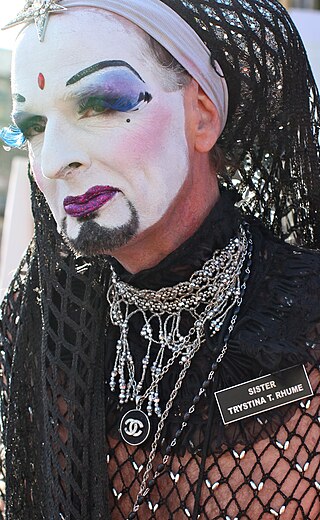
A gender bender is a person who dresses up and presents themselves in a way that defies societal expectations of their gender, especially as the opposite sex. Bending expected gender roles may also be called a genderfuck.
Michael Quatro is a keyboard player and songwriter who has released eleven albums since 1972. He specializes in keyboard-driven progressive rock.
Rockin' with Suzi Q was a weekly radio programme broadcast on BBC Radio 2, featuring Suzi Quatro playing her favourite blues, rock, and soul tunes from independent record labels.

"Can the Can" is the second solo single by American singer-songwriter Suzi Quatro and her first to reach number one in the UK, spending a single week at the top of the chart in June 1973. It also reached number one on the European and Australian charts in whose market Quatro achieved her most consistent success throughout her career as a recording artist. The single belatedly became a hit in the US peaking at number 56 on the Billboard Hot 100 in 1976. It was re-released as a single in the UK, with "Devil Gate Drive" as the B-side, in 1984, but failed to chart. The single made the charts again in 1987 in the UK at number 87, it also appeared on her 1995 album What Goes Around.
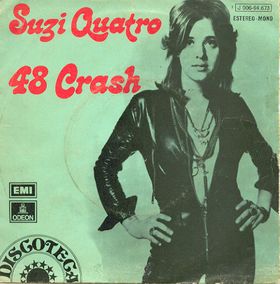
"48 Crash" is Suzi Quatro's third solo single and was released after "Can the Can". It was included on her debut album Suzi Quatro. It later appeared as a track on her 1995 album What Goes Around. The single peaked at number three in the UK in July 1973, and number one in Australia for one week. It also hit number two in Germany, and charted well in other European countries.
Art pop is a loosely defined style of pop music influenced by art theories as well as ideas from other art mediums, such as fashion, fine art, cinema, and avant-garde literature. The genre draws on pop art's integration of high and low culture, and emphasizes signs, style, and gesture over personal expression. Art pop musicians may deviate from traditional pop audiences and rock music conventions, instead exploring postmodern approaches and ideas such as pop's status as commercial art, notions of artifice and the self, and questions of historical authenticity.

Suzi ... and Other Four Letter Words, released in 1979, is the sixth studio album by American singer-songwriter, bass guitar player, and actress Suzi Quatro. By August 2012 this was still Quatro's highest-charting album in Norway and her second-highest-charting album in the United States .
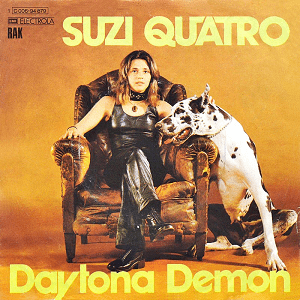
"Daytona Demon" is the fourth solo single and third UK hit by Suzi Quatro, released in 1973. The song is frequently believed to be a revision of Freddy Cannon's "Tallahassee Lassie" and a reference to Daytona Beach in Florida in which Quatro's lover is equated with a fast car.
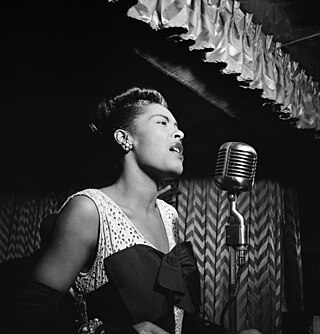
Women in music include women as composers, songwriters, instrumental performers, singers, conductors, music scholars, music educators, music critics/music journalists, and in other musical professions. Also, it describes music movements, events and genres related to women, women's issues, and feminism.

Women have made significant contributions to punk rock music and its subculture since its inception in the 1970s. In contrast to the rock music and heavy metal scenes of the 1970s, which were dominated by men, the anarchic, counter-cultural mindset of the punk scene in mid-and-late 1970s encouraged women to participate. This participation played a role in the historical development of punk music, especially in the US and UK at that time, and continues to influence and enable future generations. Women have participated in the punk scene as lead singers, instrumentalists, as all-female bands, zine contributors and fashion designers.

Heavy metal bass is the use of the bass guitar in the rock music genres of heavy metal and hard rock. The bassist is part of the rhythm section in a heavy metal band, along with the drummer, rhythm guitarist and, in some bands, a keyboard player. The prominent role of the bass is key to the metal sound, and the interplay of bass and distorted electric guitar is a central element of metal. The bass guitar provides the low-end sound crucial to making the music "heavy". The bass plays a crucial role in heavy metal and a more important role than in traditional rock."

Heavy metal guitar is the use of highly-amplified electric guitar in heavy metal. Heavy metal guitar playing is rooted in the guitar playing styles developed in 1960s-era blues rock and psychedelic rock, and folk harmonic traditions and it uses a massive sound, characterized by highly amplified distortion, extended guitar solos and overall loudness. The electric guitar and the sonic power that it projects through amplification has historically been the key element in heavy metal. The heavy metal guitar sound comes from a combined use of high volumes and heavy distortion.

Women in rock describes the role of women singers, instrumentalists, record producers and other music professionals in rock music and popular music and the many subgenres and hybrid genres that have emerged from these genres. Women have a high prominence in many popular music styles as singers. However, professional women instrumentalists are uncommon in popular music, especially in rock genres such as heavy metal. "[P]laying in a band is largely a male homosocial activity, that is, learning to play in a band is largely a peer-based... experience, shaped by existing sex-segregated friendship networks. As well, rock music "...is often defined as a form of male rebellion vis-à-vis female bedroom culture."

A rock band or pop band is a small musical ensemble that performs rock music, pop music, or a related genre. A four-piece band is the most common configuration in rock and pop music. In the early years, the configuration was typically two guitarists, a bassist, and a drummer. Another common formation is a vocalist who does not play an instrument, electric guitarist, bass guitarist, and a drummer. Instrumentally, these bands can be considered as trios. Sometimes, in addition to electric guitars, electric bass, and drums, also a keyboardist plays.
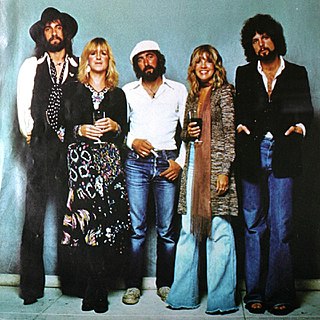
A mixed-gender band is a musical group in popular music that is composed of both male and female musicians, including instrumentalists, and is not entirely limited to vocalists, the latter being a co-ed group. Historically, such arrangements have been rare, with a substantial majority of bands being all male. This has been attributed to both social pressures making males more likely to take up musical instruments typical of a band such as guitars and drums, and the history of forming bands as an exercise in male bonding. Most mixed-gender bands feature a lineup of male instrumentalists with one female member as lead vocalist. A smaller number of mixed-gender bands feature multiple female members, or female members performing primarily as instrumentalists.














